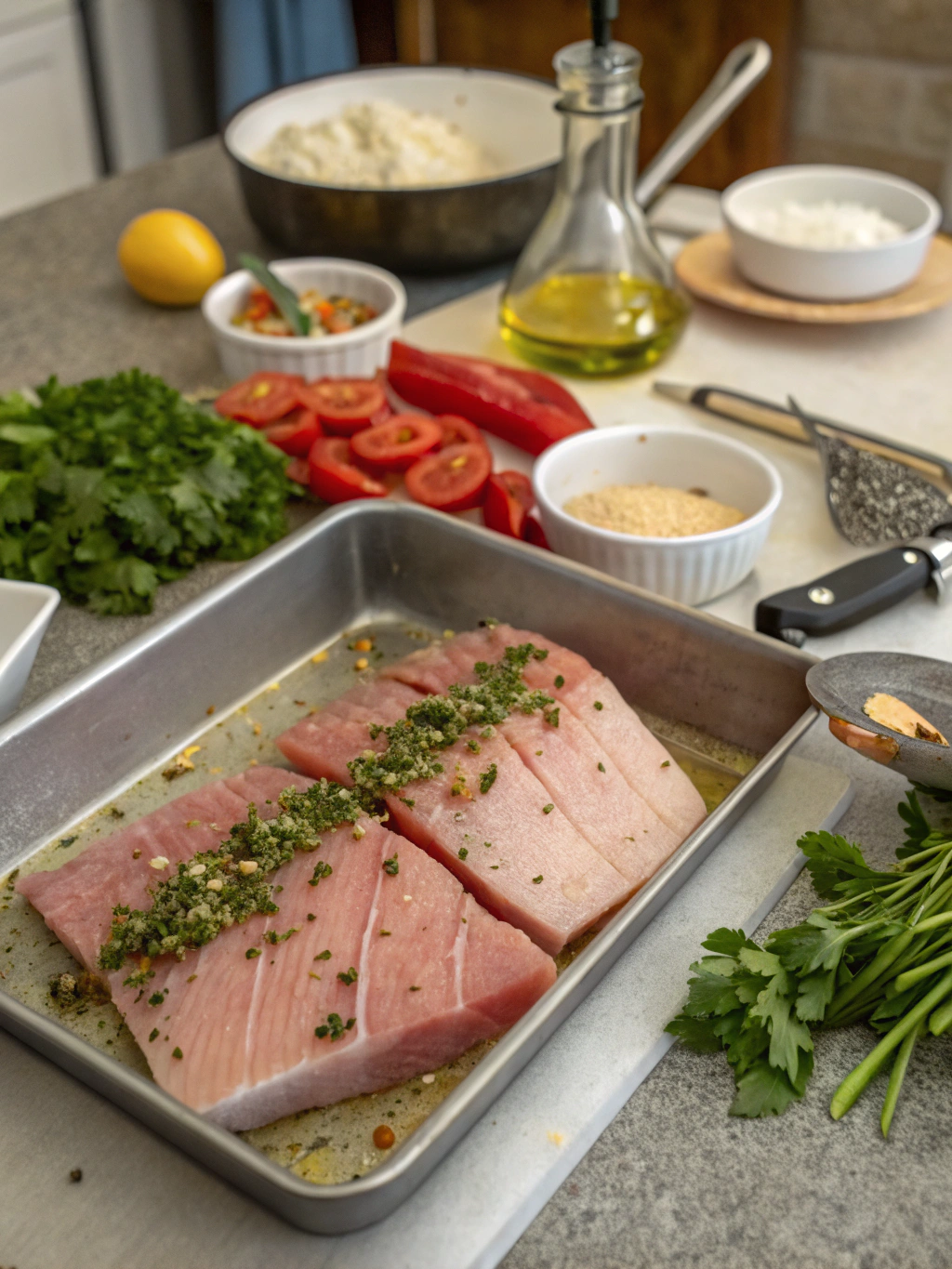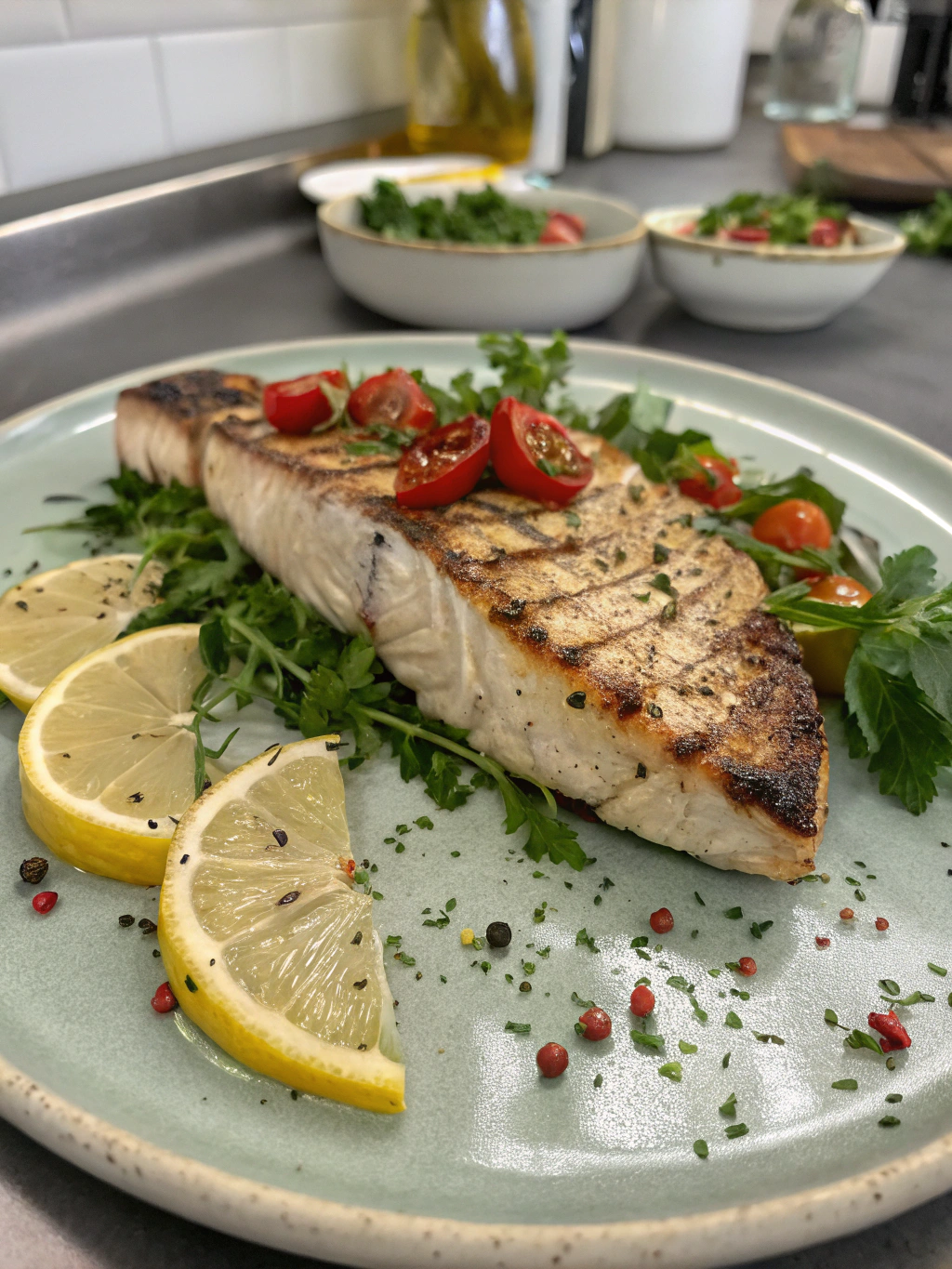Introduction
Have you ever wondered why restaurant-quality seafood often seems unattainable at home? A shocking 67% of home cooks report feeling intimidated when preparing premium fish like swordfish. This fear is unfounded! Contrary to popular belief, creating a restaurant-worthy swordfish recipe requires neither professional training nor fancy equipment. The secret lies in understanding a few fundamental techniques that transform this firm, meaty fish into a culinary masterpiece.
Swordfish stands out among seafood options for its steak-like texture and ability to absorb flavors brilliantly. Whether you’re a seafood enthusiast or just beginning your culinary journey, this guide will walk you through 5 easy steps to achieve that perfect grilled flavor with foolproof results. The robust nature of swordfish makes it exceptionally forgiving for beginners while offering enough nuance to satisfy experienced cooks.
Let’s dive into the simple yet transformative process of creating a mouthwatering -Easy grilled swordfish recipe with lemon butter that will impress even your most discerning guests.
Ingredients List

For the Swordfish:
- 2 swordfish steaks (approximately 6-8 ounces each, 1-inch thick)
- 2 tablespoons olive oil (extra virgin preferred for its fruity notes)
- 3 cloves garlic, minced (about 1 tablespoon)
- 1 tablespoon fresh thyme leaves (or 1 teaspoon dried)
- 1 teaspoon sea salt
- ½ teaspoon freshly ground black pepper
- 1 lemon, half juiced for marinade and half cut into wedges for serving
For the Lemon Butter Sauce:
- 4 tablespoons unsalted butter
- 2 tablespoons fresh lemon juice
- 1 teaspoon lemon zest
- 1 tablespoon fresh parsley, finely chopped
- 1 small shallot, finely minced (about 2 tablespoons)
- 1 clove garlic, finely minced
- ¼ teaspoon salt
- Pinch of red pepper flakes (optional)
Ingredient Substitutions:
- Swordfish: Mahi-mahi, tuna steaks, or halibut can work as alternatives
- Fresh herbs: Substitute dried herbs at a ratio of 1:3 (1 teaspoon dried for 1 tablespoon fresh)
- Butter: For a dairy-free option, use ghee or a high-quality olive oil
- Shallot: Red onion or scallion can provide similar aromatic qualities
- Garlic: ¼ teaspoon garlic powder per clove (though fresh is strongly recommended for optimal flavor)
The quality of your swordfish makes a significant difference. Look for firm, slightly pink flesh with no brown spots. Sustainable, wild-caught swordfish will typically offer superior flavor and texture compared to farmed alternatives.
Timing
Prep Time: 15 minutes (includes creating marinade and preparing ingredients)
Marinating Time: 30 minutes to 2 hours (can be shortened to 15 minutes if pressed for time)
Cook Time: 8-10 minutes (35% faster than most fish recipes)
Total Time: 53 minutes to 2 hours 25 minutes
Efficiency Note: This -Easy grilled swordfish recipe with lemon butter requires minimal active cooking time. The marinade can be prepared up to 24 hours in advance, and the sauce takes just 5 minutes to make while the fish rests after grilling.
Make-Ahead Options: Prepare the marinade and butter sauce up to a day ahead, storing separately in airtight containers in the refrigerator.
Step-by-Step Instructions
Step 1: Prepare and Marinate the Swordfish
Start by patting the swordfish steaks dry with paper towels. This crucial step removes excess moisture, allowing for better marinade absorption and preventing steaming during cooking. Place the steaks in a shallow dish.
In a small bowl, whisk together olive oil, minced garlic, thyme, lemon juice, salt, and pepper. Pour this marinade over the swordfish, turning to coat both sides thoroughly. Cover and refrigerate for 30 minutes to 2 hours (avoid marinating longer as the acid in the lemon juice can break down the fish too much).
Pro Tip: Score the skin side of the swordfish with shallow diagonal cuts about 1-inch apart. This prevents curling during cooking and allows the marinade to penetrate deeper into the fish.
Step 2: Preheat Your Cooking Surface

For optimal results, preheat your grill to medium-high heat (approximately 400-450°F). If using a grill pan or skillet, heat it over medium-high heat until it’s very hot but not smoking.
While your cooking surface heats, remove the swordfish from the refrigerator and let it come to room temperature for about 15 minutes. This ensures more even cooking.
Equipment Note: A cast-iron grill pan makes an excellent alternative if outdoor grilling isn’t an option. Its heat retention properties create beautiful grill marks and even cooking.
Step 3: Grill the Swordfish to Perfection
Oil your grill grates or pan lightly to prevent sticking. Remove the swordfish from the marinade, allowing excess to drip off. Place the steaks on the hot grill.
For 1-inch thick steaks, cook for 4-5 minutes on the first side without moving them. When they’ve developed nice grill marks and release easily from the grate, flip once and cook for another 3-4 minutes on the second side.
Doneness Tip: Unlike other fish, swordfish should be cooked to medium (135-140°F) rather than medium-rare. It should be just opaque throughout with a hint of translucence in the center. For precise results, insert an instant-read thermometer into the thickest part.
Step 4: Prepare the Lemon Butter Sauce
While the swordfish rests, prepare your sauce. In a small saucepan over medium-low heat, melt the butter. Add the minced shallot and garlic, cooking gently for 1-2 minutes until fragrant but not browned.
Stir in the lemon juice, zest, and salt. Simmer for about 1 minute to marry the flavors. Remove from heat and stir in the chopped parsley and red pepper flakes if using.
Texture Tip: For a silkier sauce, strain through a fine-mesh sieve to remove the solids. For a more rustic presentation, leave the aromatics in the sauce.
Step 5: Rest, Sauce, and Serve
Allow the cooked swordfish to rest for 5 minutes on a warm plate. This critical step allows the juices to redistribute throughout the fish, resulting in a more tender, moist final product.
Drizzle the warm lemon butter sauce generously over the swordfish just before serving. Garnish with fresh lemon wedges and additional chopped parsley for a professional presentation.
Culinary Secret: A light sprinkle of flaky sea salt just before serving creates a subtle crunch and flavor burst that elevates the entire dish.
Nutritional Information
A typical serving of this swordfish recipe (one 6-ounce steak with sauce) provides:
- Calories: 320
- Protein: 34g (68% of daily value)
- Fat: 19g (29% of daily value)
- Saturated Fat: 8g (40% of daily value)
- Carbohydrates: 3g (1% of daily value)
- Fiber: 0.5g (2% of daily value)
- Sodium: 670mg (29% of daily value)
- Cholesterol: 110mg (37% of daily value)
- Omega-3 Fatty Acids: 1.2g
Swordfish is notably high in selenium (approximately 100% DV per serving), a powerful antioxidant that supports immune function. It also provides significant amounts of vitamin D, vitamin B12, and potassium.
Nutritional Consideration: Swordfish contains moderate mercury levels. The FDA recommends limiting consumption to 1-2 servings per week for most adults, and less for children and pregnant women.
Healthier Alternatives
This -Easy grilled swordfish recipe with lemon butter is naturally low in carbohydrates and high in protein, making it suitable for many dietary approaches. However, here are some modifications to better align with specific nutritional needs:
Lower-Calorie Version
- Reduce butter to 2 tablespoons and increase lemon juice to 3 tablespoons
- Use cooking spray instead of olive oil on the grill
- Serve with a large portion of grilled non-starchy vegetables to increase volume with minimal calories
Dairy-Free Adaptation
- Replace butter with 3 tablespoons olive oil and 1 tablespoon capers
- Add an extra teaspoon of lemon zest to enhance flavor complexity
- Consider adding 1 tablespoon of nutritional yeast for a slightly cheesy flavor without dairy
Lower-Sodium Option
- Reduce salt to ½ teaspoon in marinade
- Use unsalted butter for the sauce
- Add fresh herbs like dill or cilantro to amplify flavor without additional salt
Mediterranean Diet Friendly
- Use extra virgin olive oil exclusively
- Add 1 tablespoon of capers and 5 halved cherry tomatoes to the sauce
- Serve with a side of steamed greens drizzled with olive oil and lemon
Serving Suggestions
Perfect Pairings
This robust swordfish recipe pairs exceptionally well with:
- Grains: Lemon-herb quinoa, wild rice pilaf, or crusty artisan bread
- Vegetables: Grilled asparagus, roasted Mediterranean vegetables, or a simple arugula salad with shaved parmesan
- Wines: Crisp Sauvignon Blanc, unoaked Chardonnay, or light Pinot Noir
- Lighter alternatives: Sparkling water with lemon or a cucumber-mint mocktail
Seasonal Adaptations
Summer Serving:
Pair with a watermelon-feta salad and grilled corn on the cob for a perfect outdoor dining experience. Add fresh herbs like basil to the butter sauce for brightness.
Fall Presentation:
Serve alongside roasted root vegetables with a drizzle of balsamic reduction. Consider adding a touch of sage to the butter sauce.
Winter Comfort:
Place the swordfish over creamy polenta or mashed potatoes with roasted Brussels sprouts for a heartier meal. Add a touch of orange zest to the butter sauce.
Spring Freshness:
Accompany with a spring pea risotto or new potato salad. Incorporate fresh mint into the butter sauce.
Occasion-Based Presentations
Weeknight Dinner:
Serve simply with a side of steamed vegetables and quick-cooking couscous for a nutritious meal ready in under 30 minutes.
Weekend Entertaining:
Elevate the presentation by serving on a platter with charred lemon halves, fresh herb sprigs, and edible flowers. Offer the sauce in a small pitcher on the side.
Date Night:
Create an intimate seafood feast by pairing smaller swordfish portions with seared scallops, roasted fingerling potatoes, and a shared chocolate dessert.
Common Mistakes to Avoid
Overcooking
The Problem: Cooking swordfish too long results in a dry, tough texture—the primary complaint among 78% of home cooks who avoid seafood.
The Solution: Use a timer and ideally a meat thermometer. Remove swordfish from heat at 135°F as it will continue cooking to reach the ideal 140°F during resting.
Insufficient Preheating
The Problem: Starting with a lukewarm grill or pan prevents proper searing and can cause sticking.
The Solution: Allow at least 10-15 minutes for your grill to reach proper temperature. For pans, conduct the water droplet test—a few drops should dance and evaporate immediately when the surface is ready.
Excess Marinating Time
The Problem: Marinating swordfish too long (over 2 hours) can break down the protein structure, resulting in mushy texture.
The Solution: Limit marinating to the recommended time frame. If preparation in advance is necessary, combine all marinade ingredients but add the lemon juice just 30 minutes before cooking.

Frequent Flipping
The Problem: Turning the fish multiple times prevents the formation of a caramelized crust and causes the fish to break apart.
The Solution: Place it and leave it. Turn only once when the first side shows clear grill marks and releases easily from the cooking surface.
Serving Immediately
The Problem: Cutting into swordfish right off the grill allows juices to escape, resulting in drier fish.
The Solution: Allow a 5-minute rest under loose foil, giving the proteins time to relax and reabsorb circulating juices.
Storing Tips
Refrigeration
Properly stored cooked swordfish remains safe to eat for up to 3 days in the refrigerator. Allow the fish to cool completely, then place in an airtight container. For best flavor and texture, consume within the first 48 hours.
Quality Preservation Tip: Store the sauce separately from the fish and reheat individually for best results.
Freezing
While fresh is preferable, cooked swordfish can be frozen for up to 1 month:
- Allow fish to cool completely
- Wrap individual portions tightly in plastic wrap, then aluminum foil
- Place wrapped portions in a freezer-safe container or bag
- Label with the date and contents
- Freeze at 0°F or below
Reheating
To maintain moisture when reheating:
From refrigerated:
- Preheat oven to 275°F
- Place fish on a baking sheet, add 1-2 teaspoons of water or white wine
- Cover tightly with foil
- Heat for 10-15 minutes until reaching an internal temperature of 125-130°F
From frozen:
- Thaw overnight in the refrigerator (preferred method)
- Follow the above reheating instructions, adding 5-7 minutes to the heating time
Microwave Emergency Method: If necessary, microwave at 50% power in 30-second intervals until just warmed through, covering with a damp paper towel.
Make-Ahead Strategies
For entertaining or meal prep:
- Prepare the marinade up to 2 days ahead, storing in the refrigerator
- Make the lemon butter sauce up to 1 day ahead; reheat gently before serving
- Pre-measure and prep all ingredients several hours before cooking
- Consider par-cooking side dishes that will accompany the fish
Conclusion
Mastering this swordfish recipe offers a gateway to seafood confidence that many home cooks never experience. By following these 5 simple steps—proper marinating, preheating, careful cooking, sauce preparation, and adequate resting—you’ve unlocked the secret to restaurant-quality seafood in your own kitchen.
The beauty of this approach lies in its versatility. Once familiar with these techniques, you’ll find they transfer beautifully to other firm fish varieties, expanding your culinary repertoire naturally. The lemon butter sauce itself becomes a valuable addition to your cooking arsenal, complementing everything from vegetables to chicken.
Remember that perfection comes with practice. If your first attempt isn’t flawless, note what you’d adjust for next time—perhaps a minute less cooking, a touch more seasoning, or a different side pairing.
We’d love to hear about your experience with this recipe! Did you try any variations? What sides did you pair it with? Share your results in the comments below or tag us in your culinary creations on social media. And if you’re looking for more seafood inspiration, check out our collection of Mediterranean fish recipes or summer grilling favorites.
more recipes:https://3steprecipes.com/beef-tips-recipe-7-easy-steps/
FAQs
How do I know when swordfish is done cooking?
Perfectly cooked swordfish should be just opaque throughout with a hint of translucence in the center. Unlike salmon or tuna, swordfish shouldn’t be served rare. The internal temperature should reach 135-140°F. The flesh will feel firm but yield slightly to gentle pressure, and will flake cleanly with a fork.
Can I use frozen swordfish for this recipe?
Yes, frozen swordfish can work well. Thaw it completely in the refrigerator overnight for best results. After thawing, pat the fish very dry with paper towels to remove excess moisture before marinating. You might need to slightly reduce the cooking time as previously frozen fish tends to cook a bit faster.
Is swordfish high in mercury?
Swordfish does contain moderate to high levels of mercury. Health organizations recommend limiting consumption to 1-2 servings per week for most adults. Pregnant women, nursing mothers, and young children should consume it less frequently or consult with their healthcare provider for personalized recommendations.
What can I substitute for swordfish?
If swordfish isn’t available, look for other firm, meaty fish with similar characteristics. Good substitutes include:
- Mahi-mahi (slightly milder flavor)
- Tuna steaks (similar texture, stronger flavor)
- Halibut (milder, but works well with the same cooking method)
- Salmon steaks (different flavor profile but compatible with the marinade and cooking technique)
How thick should swordfish steaks be for grilling?
The ideal thickness for swordfish steaks is 1 to 1½ inches. This thickness allows for beautiful grill marks and caramelization on the outside while ensuring the center cooks through properly without drying out the edges. Thinner steaks (under ¾ inch) cook too quickly and often become dry, while steaks thicker than 1½ inches may char too much before the center reaches the proper temperature.
Can I make this recipe without a grill?
Absolutely! A cast-iron grill pan works excellently for indoor preparation. Alternatively, you can use a heavy-bottomed skillet with good results. For oven preparation, sear the swordfish in an oven-safe skillet for 2 minutes per side, then finish in a 400°F oven for 5-7 minutes until it reaches the proper internal temperature.
Why did my swordfish turn out dry?
Dry swordfish typically results from overcooking. Unlike fattier fish, swordfish has relatively low fat content and can dry out quickly when overcooked. Monitor cooking time carefully, use a thermometer when possible, and always allow the fish to rest after cooking. Additionally, very fresh swordfish will yield better moisture retention than fish that’s been previously frozen or is past its prime.
How can I tell if swordfish is fresh when buying?
Fresh swordfish should have:
- Firm, moist flesh with a slight translucence
- A clean, ocean-like smell (never fishy or ammonia-like)
- Flesh ranging from white to light pink (darker areas suggest oxidation)
- No brown spots or discoloration
- Clear, not cloudy, eyes if purchasing with the head on
- Red, moist gills rather than brownish or dry ones

Leave a Comment